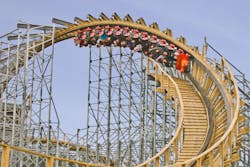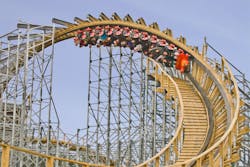Worried about the U.â S. trade deficit with China? There is one U.â S. product the Chinese can’t get enough of: wooden roller coasters. At least that is the impression one gets from The Gravity Group LLC, an engineering firm in Cincinnati specializing in the design of wooden roller coasters. “Wooden coasters are a fascination of the Chinese, perhaps because they don’t use timber for construction much in China,” says Gravity Group co-owner and P.â E. Korey Kiepert. “Concrete and steel form the backbone of most construction in China, so the Chinese look at wooden coasters as being more thrilling than those made with steel.”
Gravity Group did the engineering on China’s first wooden roller coaster, which opened in 2009. Constructed in Shanghai, the coaster is about 110-ft tall with a first drop of a little more than 100 ft. Two six-car trains travel over about 3,800 ft of twisted track and reach 56 mph. Another four wooden coasters are currently under construction at other Chinese theme parks. The style of rides range from ground-hugging terrain coasters to cutting-edge wooden coasters that go upside down.
Wooden roller coasters get their name from their use of running rails made of flattened steel strips that mount on laminated wooden tracks, though their support structure may be a steel lattice or truss as well as wood. The ride on a wooden coaster is much different than on steel roller coasters. It tends to be uneven and a bit more hair-raising than on steel versions because the wooden track moves perhaps as much as three-quarters of an inch as a train passes. This may give riders the idea that the whole affair is a bit rickety.
Of course, the supports and track systems are designed to give a bit with the force. The deflection of the track acts like a shock absorber and reduces the instantaneous force applied.
Nevertheless, it has been considered impractical for wooden coaster designs to incorporate super-extreme features such as inverted sections or highly banked turns. That was the thinking until 2005 when the Gravity Group created the first wooden coaster with a 90° banking turn. Last year, the firm refitted a wooden coaster called Hades 360 at the Mt. Olympus Theme Park in Wisconsin Dells, Wis., with a corkscrew that twists upside-down and a severe 110° overbanked turn.
The Hades 360 ride is the only wooden tracked inversion in existence. It originally opened in 2005 as one of the world’s largest wooden coasters, featuring 1,400 ft of underground tunnels and the steepest first drop on any wooden coaster.
Gravity Group co-owner and P.â E. Chad Miller says designing supports for the inverted section was a particular challenge. “You typically build a lattice structure underneath the track. But you can’t build anything under the inverted track because that is where the car needs to be,” Miller explains. “We had to come up with supports that wouldn’t come out over the cars to such an extent that they hid everything because the park wanted an open feeling to the inversion.”
So Gravity Group engineers created a normal coaster structure with cantilevered ledgers. The ledgers, basically wooden beams, hold the wooden track. But ordinary wood track wouldn’t work on the severe angles involved in the inverted section. Typical wooden-coaster track has rails made from laminated pressure-treated pine. A thin strip of steel goes atop the completed rail to form a riding surface for the coaster wheels. Each wooden layer is a 2 × 10 or 2 × 12, but Gravity Group engineers found they couldn’t twist lumber this size severely enough to handle the necessary turns. “For inversion, we had track twists that were probably 50% more severe than anything we’d done before,” explains Miller. “Ordinary 2 × 12s wouldn’t twist enough (without breaking). So we used 2 × 12s that were planed down to an inch thick.”
To make the tracks strong enough, Gravity Group engineers fashioned them from 12 of the planed-down pieces rather than the eight 2 × 12s normally used. The pieces also get glued together, in addition to the nails normally used.
Modeling such a structure can be a little tricky. Miller says wood is notoriously hard to model, so Gravity engineers erred on the side of caution by treating the track as eight independent layers of wood with no beam action. Their design software includes a structural-analysis package from RISA Technologies, Foothill Ranch, Calif., as well as specialized routines they’ve written themselves. Miller says engineers there did simulations that included putting moving loads on the track model at 20 different spots to determine stress distributions.
There are more tests once the track is installed and the coaster cars are ready to go. “We do accelerometer tests to make sure what we see is what we expect,” says Miller. “There is always a chance the person cutting the wood in the field has deviated from the design specs.”
But the inverted coaster wouldn’t have been practical without technological advances in coaster cars. Trains of ordinary cars for wooden coasters can’t follow the severe twists of inverted tracks. Nor are their restraint systems designed for inversion. That changed in 2011 with the advent of coaster cars equipped with wheels that steer so they can better follow severe track turns. Steerable wheels have long been a staple of steel coasters, but cars made by a sister company of the Gravity Group were the first to incorporate steering for wooden tracks.
“On steel coasters, there isn’t much forgiveness between the wheels and the track. The wheels have had to steer to follow the track because they are spring-loaded against the track sides,” explains Miller. In contrast, wooden-coaster wheels have historically been on fixed axles. Builders leave a small gap between the wheels and side of the track so the train “floats” through turns without exactly following the curve of the track. The result has been more banging around as the train made turns, and the banging causes track wear because it eventually crushes the wood. “The introduction of steering eliminates some of that fudge factor and ride roughness,” Miller says. “Wood coaster design and installation is getting more precise so it was just time for wooden coasters to adopt steering.”
Those riding in these new trains may see accelerations hitting 3 gs on average as they zoom up a hill, compared to about 5 gs for a steel coaster. Gravity also tries to build “air time” into its rides so riders might experience a small amount of negative g, depending on the situation. “We think the air time is the fun part,” says Miller. “Though some of our competitors keep their rides to 0 g at most.”
Coaster trains and tracks have evolved over time, and so has the design process used to realize them. “Computers now let us know a lot more about each point in the ride. We can form banks with smooth-curve algorithms and we can use splines to transition from straight track to curves. It is a lot easier to do that when the computer handles the calculations,” Miller says. “We can also change the shape of the track and see how that changes the forces on riders in real time. It is a far cry from when I started in this business 16 years ago. We still do 90% of our work with AutoCAD and spreadsheets, but the availability of more computing power and some clever programming has made a big difference.”
About the Author
Leland Teschler
Lee Teschler served as Editor-in-Chief of Machine Design until 2014. He holds a B.S. Engineering from the University of Michigan; a B.S. Electrical Engineering from the University of Michigan; and an MBA from Cleveland State University. Prior to joining Penton, Lee worked as a Communications design engineer for the U.S. Government.



